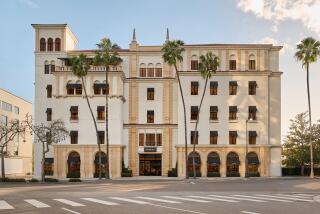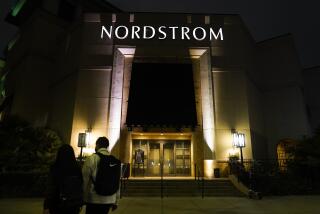Bullock’s Wizard Trying His Hand at Neiman Marcus
- Share via
DALLAS — It was enough to make a customer-minded merchant cringe.
One Saturday late last year, soon after Allen I. Questrom became president and chief executive of Neiman Marcus, a letter from an indignant Connecticut customer crossed his desk.
During a holiday outing, the shopper had received lousy service. The last straw came when she had to drive 90 miles back to a suburban New York store to pick up the charge card that a clerk had failed to return after a purchase.
“That was an absolutely terrible story,” said Questrom, a seasoned retailer who a few years ago helped turn around the Bullock’s department stores in Southern California with an emphasis on service. “Eighty years of doing things well can go awry when we screw up.”
He immediately called the woman, sent her a gift certificate and asked her to “give us another chance.” He also circulated her letter to Neiman Marcus employees as a stern reminder that the customer always comes first.
If complaints about shoddy retail service sound all too familiar these days, Questrom knew well that it was a deeply troubling sign for a store once renowned for high fashion and exemplary treatment of customers. Since 1907, the store has prided itself on a principle of co-founder Herbert Marcus Sr.: “We want to sell satisfaction, not just merchandise.”
But before Questrom’s arrival in September, 1988, signs had emerged that the store’s lustrous image had become somewhat tarnished. Merchandise was no longer as fresh. The oil-related downturn in Texas drained the spending power of many of Neiman Marcus’ best customers, and many store interiors faded along with business. Profit margins shrank.
Neiman Marcus was still a venerable name, but General Cinema Corp. of Chestnut Hill, Mass., which owns 59% of the chain’s parent, Neiman Marcus Group, wanted more oomph. It brought in Questrom to try to restore the shine. At the same time, Richard Marcus--grandson of Herbert, son of legendary merchant Stanley Marcus and the last member of the founding family to run the operation--left to become a consultant, marking the end of one of retailing’s most famous eras.
Now well into his second holiday season at the tony Texas-based chain, Questrom has already brought improvements in merchandising and operating profits. But he acknowledges that there is still some distance to go.
“We have been, in the year I’ve been here, trying to focus on our heritage and culture and (on) having the best assortments supported by service,” Questrom said in a recent interview at his art-studded office above the Neiman Marcus flagship store in downtown Dallas. “We’re trying to bring (the stores) up to ‘90s standards.”
In the past year, he has increased the sales staff by 8% to 10% and beefed up training, while reducing headquarters staff in Dallas to cut administrative expenses.
He has also invoked his “80% rule” to ensure that 80% of the merchandise on the selling floor is always less than 3 months old. To achieve that, the 23-store chain has aggressively marked down merchandise to get rid of stale inventory.
At the same time, Questrom has been coping with profit-draining merchandising problems at the exclusive Horchow mail-order business that Neiman Marcus bought last year. In that, he has been helped by a strong growth spurt in Neiman Marcus’ own mail-order operation and a new state-of-the-art mail-order distribution facility in Las Colinas, outside Dallas.
And he has overseen an ambitious, costly program of remodeling stores and selecting sites for new ones, with a goal of opening as many as 10 new stores by 1995. Neiman Marcus Group, which also owns Bergdorf Goodman and Contempo Casuals, expects to spend about $200 million over the next three years on renovating and expanding Neiman Marcus stores, which accounted for about 75% of the group’s nearly $1.5 billion in sales for the year ended July 29.
Questrom, regarded as one of the most personable executives in retailing, seems to be taking all these assignments in stride, despite rigorous travel demands that keep him on the road five days a week.
A Boston native who sold his Hollywood Hills home to pop star Madonna for $3 million when he left for Dallas, he claims to be adjusting well to life in Texas. He has even spent a fair amount of time on horseback to help promote this year’s Western-themed Christmas catalogue.
As if to show that a bespectacled Yankee can, indeed, be a cowboy, Questrom is sending friends and associates a “Genuine Texas Greeting” card featuring him and his wife, Kelli, on horseback, shot on location at the Y. O. Ranch in Kerrville, Tex., during a photo session for Neiman Marcus’ annual Christmas catalogue.
Hitting the trail for Neiman Marcus must seem like a picnic to Questrom after the hectic days of 1988, when Toronto developer Robert Campeau waged a successful five-month battle to take over Federated Department Stores, of which Questrom was vice chairman.
When the deal was done, Questrom received a lucrative golden parachute that ensured he really wouldn’t have to work at all. And he turned down Campeau’s offer of the top post at Federated.
After considering several options, a few months later Questrom chose Neiman Marcus. By September, 1988, he was back in the saddle to do what he does best--put a brighter shine on a well-known retailing franchise.
On a walk through Neiman Marcus’ lavishly decorated flagship store, Questrom demonstrated the people skills that have helped him rise to one of the most prestigious jobs in retailing. Dressed nattily in pin-striped suit, striped shirt and suspenders, he greeted employees and customers by name, his sharp Boston accent standing out among the soft Texas drawls.
There are advantages to life in Dallas. Questrom now gets to work in eight minutes, a vast improvement over the traffic-clogged drive that he faced daily to Bullock’s downtown Los Angeles headquarters. Although he and his wife miss their view from the hills, they enjoy the area of Dallas in which they rent a townhouse.
Kelli, known for renovating houses, is still searching Dallas for the ideal home that “requires just the right amount of construction,” Questrom said.
Because of his frequent travels, Questrom has far less time to devote to community affairs than he did in Los Angeles, where he was an avid fund-raiser for United Way. He is on the board of the Dallas Symphony.
“I’m not home more than two days a week,” he said. “It’s a negative. I’m on the road too much.”
At 49, Questrom seems at ease with the high-end retailing business and with himself. He weighs 165, a little less than he did in high school, thanks to a regimen of regular exercise and light eating.
At Boston University, Questrom majored in finance and played quarterback on the football team. Far from wanting to become a retailer, Questrom set a goal upon graduation to go off to ski for a year. But a drought in the Northeast intervened, and his parents suggested that he look for a job instead.
One Friday he answered an ad for an executive-trainee post at Abraham & Straus, a Brooklyn-based department store division of Federated Department Stores. He began his training the next Monday, even though 18 inches of snow had fallen the night before, a bit too late to let him devote the next year to skiing.
At A&S;, he rose through the merchandise-buying ranks, leaving in 1973 to join Bullock’s, another Federated division, where he rose to executive vice president.
In 1978, Federated shifted him to Rich’s, a troubled Atlanta-based department store that had become the company’s worst performer. In 4 1/2 years, as president and then chairman and chief executive, Questrom turned it into the company’s best division.
Federated had another challenge in mind, but Questrom chose instead to take that long-postponed hiatus. He spent 10 months with Kelli skiing around the world and assessing what he wanted to do with his life. When he left, he vowed to Howard Goldfeder, Federated’s chief executive, that if he returned to retailing, it would be with Federated.
“It was a terrific sabbatical,” Questrom said. “It gave me an opportunity to think about retail and get to know my wife.”
Questrom explored opportunities in movies, airlines and manufacturing but ultimately decided that retailing seemed “a broader-perspective business, more consumer-oriented. I felt I could still make a contribution.”
He accepted the job as chairman and chief executive at Bullock’s, where he concentrated on helping the store rise above the discounting fray that was trashing department store profits at the time. He pushed Bullock’s into its own niche as a high-end department store with an emphasis on fashion and service.
In a short time, it became Federated’s leading department store division.
“He isolated it on its own pedestal,” said Thomas H. Tashjian, an analyst with Seidler Amdec Securities, a Los Angeles brokerage firm. “At Neiman Marcus, he has the same mission.”
Tashjian noted that General Cinema really “nabbed the right guy.”
“He was the only one who had successfully made the transition from department stores into upscale merchandise. He proved that it was possible.”
Dean Liles, a retail consulting partner with Deloitte & Touche in Dallas, said Questrom has already had a good effect on Neiman Marcus.
“The important thing he has done is put some focus on managing expenses and increasing productivity,” Liles said.
Former colleagues credit Questrom’s personable, self-effacing manner with helping him get the support of employees to effect turnarounds.
“He handles people magnificently,” said Herbert R. Bloch Jr., who was Bullock’s president when Questrom arrived in 1973. “He has found a way to simplify the direction of the business that’s very clear and uncluttered.”
Jack McCarley, former public affairs spokesman for Bullock’s, now owned by R. H. Macy & Co., called Questrom “an incredible motivator” who “wants his people praised.”
Indeed, Questrom still has behind his desk a sign that McCarley recalls from Bullock’s days: “There is no limit to what a person can do if they don’t mind who gets the credit.”
If Neiman Marcus’ planned expansion succeeds, though, much of the credit will undoubtedly go to Questrom. In October, Neiman Marcus opened in McLean, Va., the first new store since the Palo Alto location was launched in 1985. The chain also plans stores in Denver, Minneapolis, Cleveland and Paramus, N.J.
Although Questrom contends that the pace of store openings is cautious enough, some retail analysts have concerns. And Questrom acknowledges that it takes Neiman Marcus stores at least a couple of years to become profitable. “Neiman Marcus was tremendously successful in Dallas, but can you export that excitement to other stores, other parts of the country?” wondered Harry E. Wells III, who follows General Cinema for Adams, Harkness & Hill in Boston.
One former department store competitor in Los Angeles said Questrom’s experience at Bullock’s should help as Neiman Marcus expands into secondary markets such as Denver, where consumers are more accustomed to department stores than to high-end specialty stores.
Bloch, Questrom’s former boss, notes that Questrom’s prime challenge is one of building strong profit growth, which has eluded Neiman Marcus despite its cachet.
The chain’s “history has been one of pride rather than profit,” he said. “In the days of Stanley Marcus when it was so great, it never made a lot of money. It has expanded without being highly profitable.”
Questrom sees demographics working in his favor, as increasingly affluent baby boomers move into Neiman Marcus’ major target group: ages 40 through 50 with incomes of more than $50,000.
“We think it is viable,” he said of the expansion. “Our customer profile is now having the benefits of the baby boom.” One change designed to woo customers at the low end of that age range will be an emphasis on lines by younger designers, a key project of Joan Kaner, a former Macy’s fashion executive whom Neiman Marcus recently named senior vice president and fashion director.
General Cinema, Questrom said, is taking a long view, with the goal of investing in Neiman Marcus to make it one of the nation’s top retail performers.
With many of the choice names in retailing for sale--notably Marshall Field’s, Saks Fifth Avenue, Bloomingdale’s and Bonwit Teller--Neiman Marcus Group is mentioned as a possible acquirer.
“We will always look at what’s available,” Questrom said.
On the other hand, he added, General Cinema’s prudent, shrewd management might also consider selling Neiman Marcus--if the price were rich enough. (A major U.S. theater operator, General Cinema took the majority stake in Neiman Marcus Group when it was spun off by Los Angeles-based Carter Hawley Hale Stores, owner of the Broadway, in 1987. Last year, in an action praised by analysts, General Cinema sold its longtime Pepsi bottling business for a hefty pretax price of $1.7 billion.)
Under a three-year contract that Questrom signed with General Cinema, he is guaranteed a minimum salary of $750,000 a year and a minimum annual bonus of $150,000. But the money, Questrom maintains, isn’t the thing.
Of the lucrative salary, he said: “I don’t do things for money. I don’t need a yacht or a plane. I have the same life style as 20 years ago.
“But I do have a lot of feeling I want to do it my way. I don’t want to be in a position of having to compromise.”
And if things keep looking up at Neiman Marcus, it’s a good bet he won’t have to.
More to Read
Inside the business of entertainment
The Wide Shot brings you news, analysis and insights on everything from streaming wars to production — and what it all means for the future.
You may occasionally receive promotional content from the Los Angeles Times.











